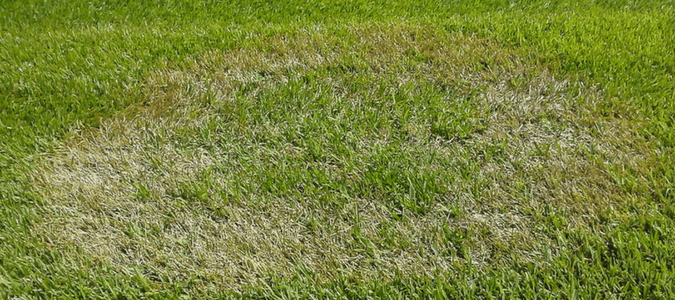
Our Texas weather can be brutal on yards and landscaping. Grass can suffer from our area’s unrelenting heat, flooding events, and lack of consistent rainfall. Another reason it may be hard to keep your grass looking its best is lawn diseases.
Some lawn disease can develop as a result of environmental factors, such as drought, shady conditions, or very high or low temperatures. Sometimes, pests are the reason behind the problem. Other diseases can be linked back to how we care for our lawns.
During cool, wet weather we have to remain vigilant against a fungus called brown patch. This disease can pose as big a threat to our turf as heat and drought.
Banish Brown Patch From Your Lawn
Below let’s look at what brown patch is, how you can identify it in your yard, and most importantly, how to get rid of brown patch in your lawn year-round.
What is Brown Patch?
Brown Patch is more common during fall, although if the conditions are right it can also show up in the spring. It thrives when nights are cool, rain is plentiful, and there’s no hot sun to dry things out between waterings.
The most common grass that’s affected by brown patch is St. Augustine grass, although other grasses such as zoysia and bermudagrass can also fall victim to this fungus.
Cool weather and rain make your lawn more susceptible to fungi like brown patch because these are the conditions in which it thrives. Over-fertilized lawns also encourage brown patch, as the fungus has a lot of healthy green growth on which to feed.
How to Identify Brown Patch
There are a number of ways you can identify your lawn problems as brown patch. Here are a few symptoms to watch out for:
- Look for circular patches of brown grass in your yard. Early these patches can be small, but as the fungus spreads, the patches can stretch up to 50 feet in diameter.
- Pull out a yellowing blade of grass. If it’s brown patch, it will be easy to remove.
- Keep an eye out for “donuts” as grass in the center of a patch grows back green, as it hasn’t (yet) been affected by the fungus.
- Keep in mind that brown patch likes cool, damp weather. If it’s still hot and summer-like, the patches are more likely to be caused by chinch bugs.
How to Treat Brown Patch
Brown patch fungus remains active in your lawn until cold weather causes your grass to go dormant. If you notice it, it’s important to act quickly and keep up preventative measures throughout the growing season to make sure it doesn’t come back.
If you find brown patch in your lawn, you have a number of different ways you can treat it.
The most important thing you can do is to ensure your lawn isn’t sitting in water. You want to continue to water your lawn in dry periods, but turn off automatic sprinklers in the fall if you’re getting supplemental rain. If water just sits in areas of your lawn, consider installing french drains or other landscaping to help promote drainage.
In addition to monitoring your watering, here are some other things you can do:
- Apply a fungicide containing bayleton, chlorothalonil, or PCNB, and apply as soon as you spot signs of fungus.
- Don’t mow your lawn too short. Taller grass will reduce plant stress and allow it to recover.
- Rake fallen leaves to make sure sun can get to your grass and dry out the damp root area.
- Dethatch your lawn to help promote drainage and discourage fungus at the soil level.
- Make sure your mower blade is sharp, again helping your lawn remain healthy.
- Don’t fertilize your soil without testing the pH and nitrogen levels. That way you can choose the correct amount of fertilizer and only apply it as necessary.
Has Brown Patch Taken Over?
If your lawn isn’t recovering despite all of your efforts, it might be time to call out the experts.
If you are concerned about your lawn, we would be happy to come out and take a look at your grass and suggest a plan of action. Give us a call and we can come out to inspect your lawn. We can test your soil and treat your lawn to make sure it recovers before spring comes around again, and offer landscaping and irrigation options that may help prevent brown patch and other lawn diseases in the future.